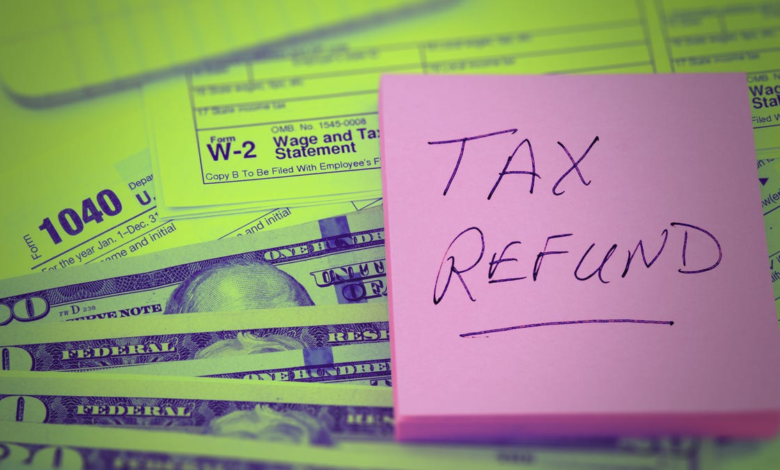I Like to Buy Stocks With Part of My Tax Refund. I Don’t Suggest That for Most People Right Now


A free option that’s great for confident filers
Cash App Taxes

Best tax filing service for freelancers, gig workers and sole proprietors
TaxSlayer
I didn’t receive a tax refund this year. But in years where I do get money back, I normally add cash to my sinking funds, treat myself to an expensive retail purchase like designer sneakers and pay off my annual credit card fees that total about $700. The latter can really sneak up on me after a year of enjoying the perks of a travel rewards credit card.
Any additional leftover cash from my tax refund is usually put into the stock market via my brokerage account. But that wasn’t an option this year.
President Donald Trump’s sweeping tariffs on imports have wreaked havoc on Americans’ retirement portfolios. The S&P 500 is down 11% since the beginning of the year. The benchmark index at one point this week lost all of its gains from the last 12 months before recovering some losses on Wednesday.
In response to this market upheaval, two schools of thought are that Americans should either “buy the dip” with the belief the market will bounce back or adjust portfolios now to limit losses. Although stocks are down, the uncertainty about the future of the economy and talks of a looming recession indicate that they could go down further.
If you’re expecting a refund this year, consider these factors before spending your refund on market investments.
Who shouldn’t invest in the market right now
If you haven’t checked all of these boxes on your financial roadmap, you’re probably not in a position to buy the dip.
You’re living paycheck-to-paycheck
About 25% of all US households in 2024 lived paycheck to paycheck, according to a Bank of America study. A recent CNET survey also found that 38% of filers plan on using tax refunds on bills or to pay down debt, as the cost of living increases because of sticky inflation.
If you’re struggling to afford your rent, bills or other necessities, we don’t recommend using part of your refund to invest right now. Instead, use it on your everyday expenses or to help start or pad a savings account.
You don’t have a fully-funded emergency fund
You should strive to have three to six months of expenses saved in a FDIC insured account — preferably a high-yield savings or money-market account that can grow your money at a higher rate than inflation.
An emergency fund is an important tool that can help you pay for unplanned expenses like a job loss, medical bill, moving expenses or, in my case, an unexpected tax bill.
Most important, an emergency fund keeps you from relying on credit cards to cover monthly expenses, helping you avoid high interest credit card debt that can be difficult to pay back.
You owe money on your credit card debt
Credit card interest rates have been high since the Federal Reserve raised the federal funds rate 11 times beginning in March 2022. Although the Fed cut interest rates three times last year, average credit card interest rates remain above 21%.
If you carry a monthly balance, interest charged to you by your credit card issuer can make it harder for you to pay off your debt. Annual market returns will generally not outpace the debt you’re accumulating by ignoring your high-interest debt.
You’re struggling to pay your student loan debt
One in four adults younger than 40 carry a student loan balance, according to Pew Research Center. Forty-two percent of borrowers owe at least $25,000.
Federal student loan interest isn’t as high as credit cards but if you’re one of the millions preparing to make payments for the first time since 2020, be sure you can fit your student loan payment into your budget before investing. You can use the student loan calculator on StudentAid.gov to figure out how much you’ll need to budget for each month.
You’re not maxing out your 401(k) or IRA accounts
Rather than trying to time the market, you can max out your 401(k) or individual retirement account contributions that let you invest in the stock market in the long term.
The maximum you can contribute to your 401(k) in 2025 is $23,500. These pre-tax contributions also reduce your tax liability, which can help you lower your tax bill or increase your refund next year. IRA contribution limits for 2025 are $7,000 and can be made pre-tax or post-tax. If you’re 50 or older, you can contribute an additional $7,500 to your 401(k) and an extra $1,000 to an IRA.
When it might make sense to invest in the stock market
If there’s anything this week has proven, it’s that markets are volatile right now. On Monday, investors rallied on reports that President Trump would consider pausing tariffs on American trade partners, only for the White House to call it “fake news.” That sent stocks plunging.
By Wednesday, President Trump did announce a 90-day pause on reciprocal tariffs. Instead, a lower 10% tariff was imposed on all countries, with the exception of China — which now faces a 125% tariff on exported goods to the US. Then, you guessed it, stocks rallied again, before tumbling slightly again on Thursday.
Experts will tell you timing the market is one of the hardest things to do. That’s why the safest bet is to invest over the long-term and ride out the ebbs and flows of the market.
If you want to “buy the dip” with your tax refund, you must be prepared to lose money, not just make it. With policies around tariffs changing seemingly by the day, this may not be rock bottom. And if you have extra money to invest via a brokerage account, consider investing in ETFs or index funds that track popular indices like the S&P 500, Nasdaq or specific industry sectors.




